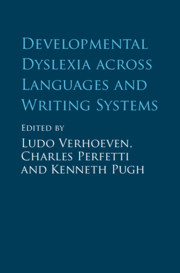Book contents
- Developmental Dyslexia across Languages and Writing Systems
- Developmental Dyslexia across Languages and Writing Systems
- Copyright page
- Contents
- Figures
- Tables
- Contributors
- 1 Introduction
- Part I Developmental Dyslexia across Languages and Writing Systems
- Part II Cross-Linguistic Perspectives on Developmental Dyslexia
- 11 Behavioral Precursors of Developmental Dyslexia
- 12 Neural Predictors of Developmental Dyslexia
- 13 Neurocognitive Markers of Developmental Dyslexia
- 14 Role of Visual Attention in Developmental Dyslexia
- 15 Morphological and Semantic Processing in Developmental Dyslexia
- 16 Modeling the Variability of Developmental Dyslexia
- 17 Modeling Developmental Dyslexia across Languages and Writing Systems
- 18 Etiology of Developmental Dyslexia
- 19 Intergenerational Transmission in Developmental Dyslexia
- Epilogue
- Index
- References
11 - Behavioral Precursors of Developmental Dyslexia
from Part II - Cross-Linguistic Perspectives on Developmental Dyslexia
Published online by Cambridge University Press: 27 September 2019
- Developmental Dyslexia across Languages and Writing Systems
- Developmental Dyslexia across Languages and Writing Systems
- Copyright page
- Contents
- Figures
- Tables
- Contributors
- 1 Introduction
- Part I Developmental Dyslexia across Languages and Writing Systems
- Part II Cross-Linguistic Perspectives on Developmental Dyslexia
- 11 Behavioral Precursors of Developmental Dyslexia
- 12 Neural Predictors of Developmental Dyslexia
- 13 Neurocognitive Markers of Developmental Dyslexia
- 14 Role of Visual Attention in Developmental Dyslexia
- 15 Morphological and Semantic Processing in Developmental Dyslexia
- 16 Modeling the Variability of Developmental Dyslexia
- 17 Modeling Developmental Dyslexia across Languages and Writing Systems
- 18 Etiology of Developmental Dyslexia
- 19 Intergenerational Transmission in Developmental Dyslexia
- Epilogue
- Index
- References
Summary
Learning to read requires mapping the units of a particular writing system onto its corresponding spoken language units. While such a mapping process is universal to all orthographies, there is considerable variation in (1) the visual characteristics of writing systems (e.g., Chinese, Arabic, Latin-based), (2) the grain size of the spoken language units that are represented by a writing system (e.g., words/morphemes in Chinese vs. phonemes in Western alphabets), and (3) the consistency and regularity of the correspondences between spoken and written language units, which is often called orthographic depth (Katz & Frost, 1992). Shallow orthographies like Finnish represent the sound structure of the spoken language in a highly consistent and transparent way while deep orthographies like English represent deeper linguistic structures (i.e. morphology) rather than the phonological surface structure of words, which makes them rather opaque to the developing reader.
- Type
- Chapter
- Information
- Developmental Dyslexia across Languages and Writing Systems , pp. 229 - 252Publisher: Cambridge University PressPrint publication year: 2019
References
- 3
- Cited by



